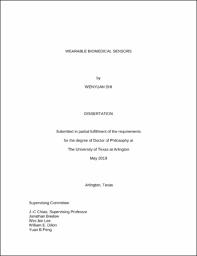
ATTENTION: The works hosted here are being migrated to a new repository that will consolidate resources, improve discoverability, and better show UTA's research impact on the global community. We will update authors as the migration progresses. Please see MavMatrix for more information.
Show simple item record
| dc.contributor.advisor | Chiao, J.-C. | |
| dc.creator | Shi, Wenyuan | |
| dc.date.accessioned | 2021-06-03T20:30:18Z | |
| dc.date.available | 2021-06-03T20:30:18Z | |
| dc.date.created | 2019-05 | |
| dc.date.issued | 2019-05-08 | |
| dc.date.submitted | May 2019 | |
| dc.identifier.uri | http://hdl.handle.net/10106/29897 | |
| dc.description.abstract | Focusing on current major research interests about the wearable biomedical sensors, numerous achievements contributed by researchers and engineers are reviewed in chapter 1. Development and research trends, as well as challenges of the wearable technologies are discussed. In chapter 2, a new double-resonance sensor was presented for monitoring body dehydration with two resonant frequencies. Using the waveguide method and the finite-element simulations, the sensor was designed with optimal parameters. Electromagnetic field distributions, Q factors, and sensitivities of the sensor are analyzed. The sensor’s equivalent circuit was deduced. The finite-element model and the equivalent circuit model were simulated for identifying various materials by the resonant frequencies. The sensor was experimentally validated by identifying pork humidity. With a wireless body network, this new wearable biomedical sensor can monitor body dehydration, and potentially used for identification of abnormal or cancerous tissues. In chapter 3, implantable biomedical sensors with wireless body area network (WBAN) are presented for Intraoperative Neuromonitoring (IONM). The wireless system was implemented with advantages of small size, low cost, high sample rate, maximum communication range over 10 m, battery life over 10 hours, and isolated electromagnetic interference from power lines and surrounding electrical equipment. Because the new WBAN system has a different frequency response from the IONM system used in hospital, a system identification method was used to find the transfer function between the two systems and was used to convert the wireless recordings to the equivalent IONM waveforms. In order to verify the WBAN performance, the muscular action signals from 20 patients were recorded by the WBAN during scoliosis correction surgeries at the Texas Scottish Rite Hospital for Children. The signals were converted and evaluated by the goodness of fit, Pearson's correlation, and root mean square errors methods. It has been demonstrated that the converted wireless recordings should be fully acceptable by the doctors. | |
| dc.format.mimetype | application/pdf | |
| dc.language.iso | en_US | |
| dc.subject | wearable | |
| dc.subject | sensors | |
| dc.subject | electromagnetics | |
| dc.subject | wireless body area networks | |
| dc.subject | intraoperative neuromonitoring | |
| dc.subject | dehydration | |
| dc.subject | | |
| dc.title | Wearable Biomedical Sensors | |
| dc.type | Thesis | |
| dc.degree.department | Electrical Engineering | |
| dc.degree.name | Doctor of Philosophy in Electrical Engineering | |
| dc.date.updated | 2021-06-03T20:30:19Z | |
| thesis.degree.department | Electrical Engineering | |
| thesis.degree.grantor | The University of Texas at Arlington | |
| thesis.degree.level | Doctoral | |
| thesis.degree.name | Doctor of Philosophy in Electrical Engineering | |
| dc.type.material | text | |
| dc.creator.orcid | 0000-0002-8995-8359 | |
Files in this item
- Name:
- SHI-DISSERTATION-2019.pdf
- Size:
- 4.419Mb
- Format:
- PDF
This item appears in the following Collection(s)
Show simple item record


